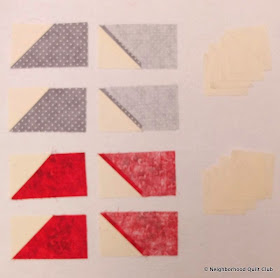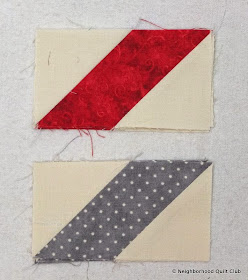 |
Double Quartet (aka Turned Around)
8" finished quilt block |
This is an easy block! I love the way it looks.
Step 1: Cutting the Fabric
Fabric A: background fabric
- A1 - cut four 3" squares
- A2 - cut four 2 1/2" squares
Fabric B: grey (medium color)
- B - cut four 2 1/2" squares
Fabric C: blue (dark color)
Step 2: Half-square Triangle Units
Hopefully half-square triangle units are getting easier to sew!
 |
Draw a diagonal line on the back of each A1 (3" square background fabric) from one corner to another.
Place each A1 (background fabric) right sides together with a C (blue or dark fabric).
Pin the pieces together so they don't shift while sewing. |
 |
| Sew a scant 1/4" seam on either side of the drawn diagonal line. I used black so you could see the stitching line easily. |
 |
| Cut along the drawn line to make eight half-square triangle units. |
 |
| I pressed my seams open. This time I put the half-square triangle unit on top of a sleeve form and ironed it. It was much easier and faster to press it open. |
 |
All eight half-square triangle units pressed open.
Not shown: trim each unit to 2 1/2" using whatever ruler you prefer.
I like using both Marsha McCloskey's 6" Precession Trimmer and Quilt in a Day 6 1/2" Square Up Ruler. I grab whichever one is on the top of my stack of rulers.
Step 3: Sewing the Block Together
|
 |
Lay out the half-square triangle units, the A2 (2 1/2" background squares), and the B (grey or medium 2 1/2" squares).
See how fast this block is? |
 |
| Press the seams open. |
 |
There is no way to nest the seams if they are pressed open so make sure you pin the rows together before you sew them! If you click on the photo below you will see that even with pinning, sewing with pressed open seams takes practice. My corners don't match up exactly.
I don't worry too much unless the seams are off a lot. By 'a lot' I mean that I could see the problem from 9 feet away! Sometimes I rip a seam out and sew it again to improve the block, but sometimes it's good enough because no one will notice the mistake.
|
If your cutting and sewing is accurate you shouldn't have to trim much more than loose threads when you are done sewing the rows together.
 |
| 8 1/2" Double Quartet (aka Turned Around) block ready to be sewn into a quilt. |
 |
Do you want a coloring page to try out different colors?
Click on the image, then print to your printer.
We use colored pencils, |
Everyone loves "Show and Tell!" Please feel free to send me a photo of your block. I'd love to see what colors you are using, so would everyone else!
Update: Reader photos!
 |
| Jaime's block: I love the colors! Notice how she was careful about the directional prints she chose for the corners. Thanks for sharing! |
If you have a question, please ask it in the comments section and I'll do my best to answer.






























